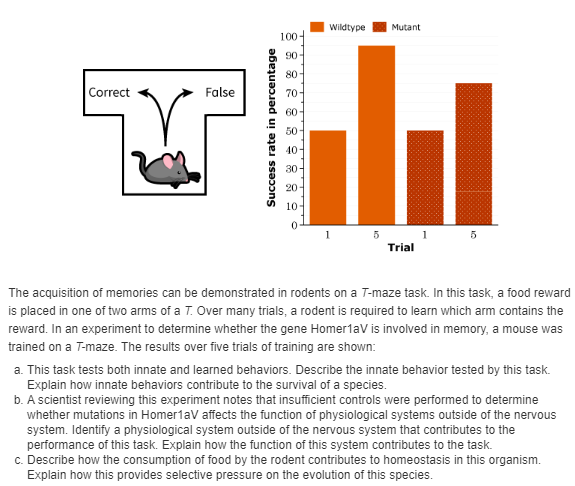The acquisition of memories can be demonstrated in rodents on a T-maze task. In this task, a food reward is placed in one of two arms of a T. Over many trials, a rodent is required to learn which arm contains the reward. In an experiment to determine whether the gene Homeriav is involved in memory, a mouse was trained on a T-maze. The results over five trials of training are shown: a. This task tests both innate and learned behaviors. Describe the innate behavior tested by this task. Explain how innate behaviors contribute to the survival of a species. b. A scientist reviewing this experiment notes that insufficient controls were performed to determine whether mutations in Homer1aV affects the function of physiological systems outside of the nervous system. Identify a physiological system outside of the nervous system that contributes to the performance of this task. Explain how the function of this system contributes to the task. c. Describe how the consumption of food by the rodent contributes to homeostasis in this organism. Explain how this provides selective pressure on the evolution of this species
The acquisition of memories can be demonstrated in rodents on a T-maze task. In this task, a food reward is placed in one of two arms of a T. Over many trials, a rodent is required to learn which arm contains the reward. In an experiment to determine whether the gene Homeriav is involved in memory, a mouse was trained on a T-maze. The results over five trials of training are shown: a. This task tests both innate and learned behaviors. Describe the innate behavior tested by this task. Explain how innate behaviors contribute to the survival of a species. b. A scientist reviewing this experiment notes that insufficient controls were performed to determine whether mutations in Homer1aV affects the function of physiological systems outside of the nervous system. Identify a physiological system outside of the nervous system that contributes to the performance of this task. Explain how the function of this system contributes to the task. c. Describe how the consumption of food by the rodent contributes to homeostasis in this organism. Explain how this provides selective pressure on the evolution of this species

Trending now
This is a popular solution!
Step by step
Solved in 2 steps








